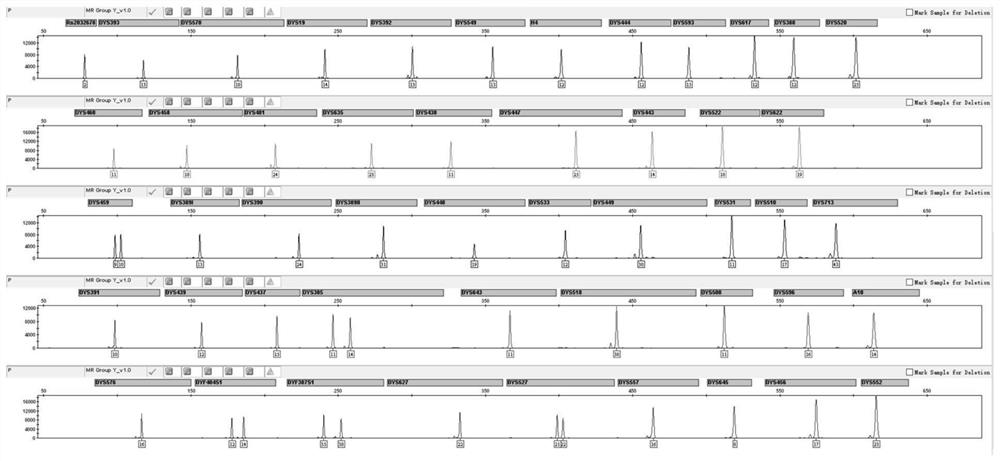Fluorescent multiplex amplification system of 54 Y chromosome loci, kit and application
A compound amplification system and Y chromosome technology, applied in the field of biological detection, can solve the problem that the locus information cannot meet the requirements of practical applications, etc., achieve high cumulative individual recognition and non-parent exclusion rate, improve utilization rate, and stability Good results
- Summary
- Abstract
- Description
- Claims
- Application Information
AI Technical Summary
Problems solved by technology
Method used
Image
Examples
Embodiment 1
[0079] Example 1: Amplification of DNA, blood card and saliva card
[0080] Take 1 ng of commonly used DNA 9948, male blood card and saliva card as templates, mix each reaction reagent according to the determined ratio, oscillate and centrifuge, and put it into a PCR instrument for amplification.
[0081] Capillary electrophoresis detection after amplification: mix the internal standard QD650 and formamide at a ratio of 3:100 and centrifuge briefly, take 9ul of the mixture and add it to a 96-well plate, then add 1μl of the amplified product sample or allele standard, Mix and let stand for several minutes, denature at 95°C for 3 minutes, immediately bathe in ice for 3 minutes, centrifuge and put on ABI3500 sequencer for detection.
[0082] Import the raw data into the GeneMapper ID-X software, and use the GeneMapper ID-X software to analyze the obtained data and generate maps.
[0083] Depend on Figure 1-Figure 5 From the results shown, it can be seen that using the system o...
Embodiment 2
[0084] Embodiment 2: Sensitivity detection
[0085] Sensitivity detection was performed using a fluorescent multiplex amplification system with 54 sites, and 9948 was used as a template for amplification. The detection spectrum is as follows Figure 6 As shown, the minimum detection sensitivity of this system is 0.06ng, and all types can be completely detected at 0.06ng.
Embodiment 3
[0086] Example 3: Species-specific detection
[0087] The specific detection of different species is carried out by using the fluorescent multiplex amplification system with 54 sites. The DNA templates of mice, pigs, dogs, cattle and sheep are taken, and the detection patterns are as follows: Figure 7 As shown, this system does not amplify bands in other species, indicating better species specificity.
PUM
| Property | Measurement | Unit |
|---|---|---|
| Sensitivity | aaaaa | aaaaa |
Abstract
Description
Claims
Application Information
 Login to View More
Login to View More - R&D
- Intellectual Property
- Life Sciences
- Materials
- Tech Scout
- Unparalleled Data Quality
- Higher Quality Content
- 60% Fewer Hallucinations
Browse by: Latest US Patents, China's latest patents, Technical Efficacy Thesaurus, Application Domain, Technology Topic, Popular Technical Reports.
© 2025 PatSnap. All rights reserved.Legal|Privacy policy|Modern Slavery Act Transparency Statement|Sitemap|About US| Contact US: help@patsnap.com



